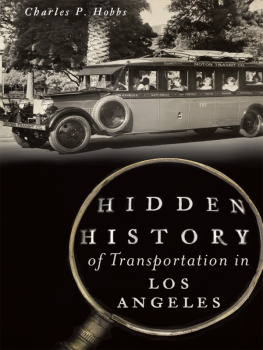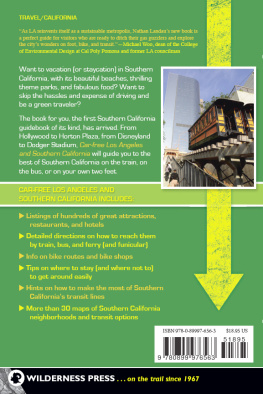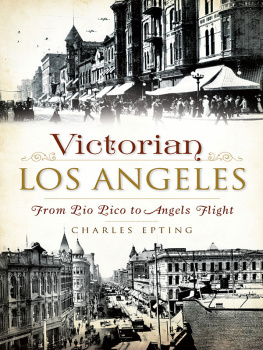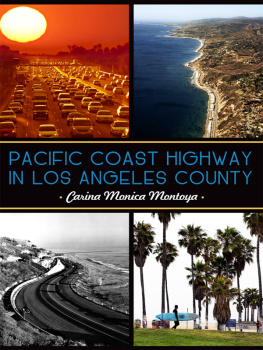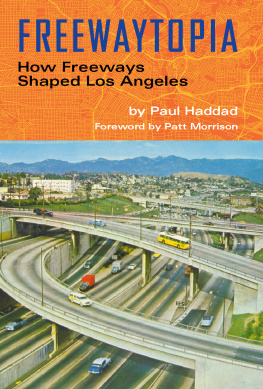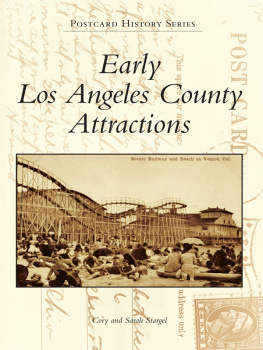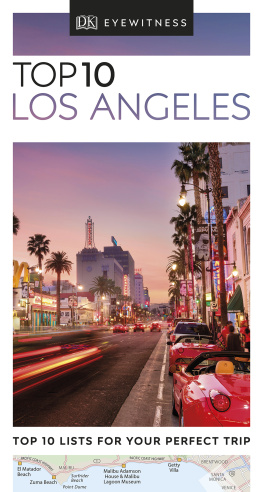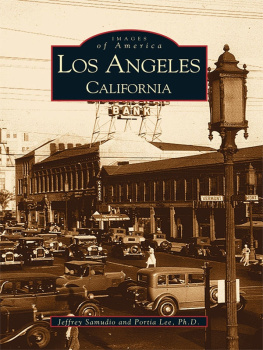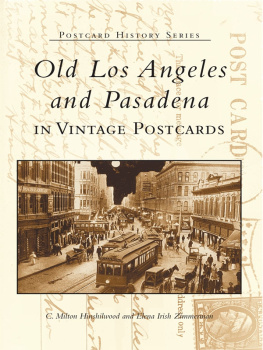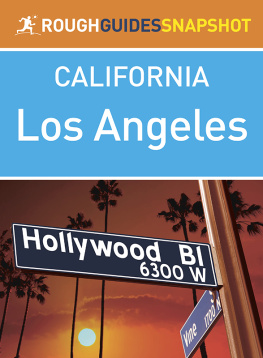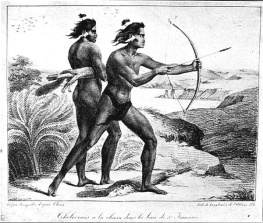
Published by The History Press
Charleston, SC 29403
www.historypress.net
Copyright 2014 by Charles P. Hobbs
All rights reserved
First published 2014
e-book edition 2014
ISBN 978.1.62585.200.7
Library of Congress Control Number: 2014952247
print edition ISBN 978.1.62619.671.1
Notice: The information in this book is true and complete to the best of our knowledge. It is offered without guarantee on the part of the author or The History Press. The author and The History Press disclaim all liability in connection with the use of this book.
All rights reserved. No part of this book may be reproduced or transmitted in any form whatsoever without prior written permission from the publisher except in the case of brief quotations embodied in critical articles and reviews.
This book is dedicated to anyonepast, present or futurewho has ever had or will have a bright idea to improve transportation in Southern California.
CONTENTS
ACKNOWLEDGEMENTS
This book could not have been written without the existence and support of several institutions and individuals. Historical societies were an important source of photographs and other information. I would like to acknowledge the Pasadena Museum of History, Burbank Historical Society, Malibu Lagoon Museum, San Pedro Bay Historical Society, Topanga Historical Society and California Historical Society.
I would like to acknowledge the staff of the following public libraries: Los Angeles Public Library, Central Branch; County of Los Angeles Public Library; and public libraries in the cities of Azusa, Burbank, Corona, Fullerton, Glendale, Glendora, Pasadena, Pomona, Ontario, Santa Monica, Simi Valley and Torrance.
Academic libraries (including Special Collections departments) that were invaluable included University of California institutions at Irvine, Los Angeles, San Diego and Santa Barbara; California State University institutions at Fullerton, Los Angeles, Northridge, Pomona and San Diego; University of La Verne; University of Southern California; Pepperdine University; Fullerton College; and Mount San Antonio College.
Libraries specializing in transportationsuch as the Dorothy Peyton Gray Transportation Library (Los Angeles County Metropolitan Transportation Authority), the Harmer E. Davis Transportation Library (Institute of Transportation Studies, University of CaliforniaBerkeley) and the Transportation Library at Northwestern Universityalso enabled much of the research that made this book possible.
The law libraries of Los Angeles, Riverside and San Bernardino Counties provided access to California Railroad Commission/California Public Utilities Commission decisions and other legal documents. The Huntington Library; the Library of Congress; the California State Library; the National Archives and Records Administration (in Washington, D.C., and Riverside, California); the Los Angeles City Records Center; and the National Air And Space Museum, Smithsonian Institution, all provided access to important historical records.
Special thanks goes to Matthew Barrett, librarian of the Dorothy Peyton Gray Transportation Library, for making its archives available when I needed them; Christina Rice of the Los Angeles Public Library, for her assistance with the librarys photo collection; Michael Holland of the Los Angeles City Records Center; and to Simon Elliott of the UCLA Library Special Collections, for helping me to obtain pictures from the Los Angeles Times collection.
I would like to thank the following individuals for granting interviews (in person or by mail, phone or e-mail): Ryan Snyder, Steve Weathers (Bug Line), Bill Forsythe (Forsythe and Associates), Peter Mobley (representing the Carson family), Michael Kadletz (Pink Bus), Mac Barnes (Ground Link), Donald Spivack (LA CRA), Barry Goldwater Jr. (Frank Hendler), Walter Williams (Thomas W. Matthew) and Richard Katz (LA River Freeway).
I would also like to thank the members of Internet Writers Workshop (IWW) Writing and Nonfiction mailing lists for critiquing my writing and suggesting improvements. The following members of the IWW Nonfiction list stand out as being particularly helpful: G.K. Adams, Diane Diekman, Ellen Dreyer, Tim Elhajj, Paul Fein, June Gallant, Pam Gregory, Mel Jacob, Janaki Lenin, Sarah Corbett Morgan, Cathy Moser, Gary Presley, Loretta Russell and Mona Vanek. However, all of the members on both mailing lists provided much-needed assistance and support.
My commissioning editor, Jerry Roberts, and my cartographer, Tom Wilcockson (Mapcraft.com), also deserve special recognition for all of the ups and downs we went through as we prepared this book. I must also thank Loren P. Meissner, author of A Brief History of Eastvale (The History Press, 2013) for letting The History Press know about my book.
Finally, I would like to thank my wife, Angelia, and daughter, Mackenzie, for their support and patience during the seven years required to bring this book to light. All of my family membersmy parents, Charles and Marva Hobbs; my in-laws, Hayward and Kizzie; my sisters, Sharon and Susanne; and my wifes siblings, Adriene, Annette and Leroyhelped in one way or another. And above all, thanks to God for perseverance and strength.
INTRODUCTION
Like countless small springs feeding a mighty river, the inspiration for Hidden History of Transportation in Los Angeles developed from many small events.
It came partly from growing up in Los Angeles, traveling via the freeways, learning to read maps and listening to radio traffic reports. It also came from my first experience with public transit in the summer of 1984. I commuted three times a week between La Verne and the University of CaliforniaIrvine using public transit. The trip, which took about five hours each way, required the use of three Southern California Rapid Transit District (RTD) buses to travel from La Verne to the Orange County line. At Brea, I would transfer to the Orange County Transit District (OCTD) buses to travel farther south to Irvine, with a connection in Santa Ana. Somehow, that onerous and tiring commute led to my lifelong fascination with public transportation.
Later that summer, I rode the bus to downtown Los Angeles. There I noticed the different transit agencies serving the central citybuses of all colors: Santa Monicas Big Blue Bus, the red-and-white buses of Torrance Transit and Gardenas green-and-yellow buses. Why so many different agencies? Wouldnt it be better to have a single transit agency go everywhere?
By 1987, I had learned that many former independent bus companies had been absorbed into RTD. There were also plans to break apart RTD into several new transit agencies. Intrigued, I sent a letter to RTD inquiring about both the historic bus companies and the future of the agency. A week later, I received a two-part letter.
The first part was a list of former bus companies with names such as Asbury Rapid Transit, Blue and White Bus Lines of Watts and Pasadena City Lines. These companies became unprofitable in the 1960s and 70s due to increasing labor costs, the proliferation of personal automobiles and other factors. RTD (or its predecessor, Los Angeles Metropolitan Transit Authority), in the interest of providing continued service, acquired the bus companies and integrated their routes into its network.
The second part was a list of RTD bus routes to be taken over by either the City or the County of Los Angeles. These were express and suburban local routes that had become costly for RTD to operate, so the agency was planning to cancel them. The City of Los Angeles was planning to operate ten of these routes under contract to a private bus company. The county also planned to operate six other former RTD routes, again using a private operator under contract.
Next page
